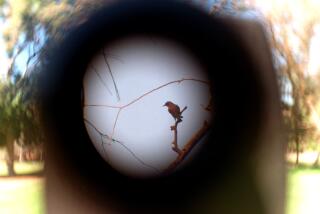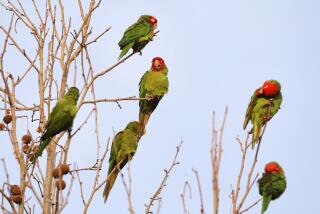Giving parrots elbow room
- Share via
Mira Tweti does plenty of squawking over the size of parrot cages.
Most, she says, are too small for the colorful birds whose charismatic and intelligent natures make them popular pets.
That’s why the Playa del Rey author and journalist -- whose last name rhymes with “tweety” -- is launching a national campaign to encourage parrot owners to swap their standard-size bird cages for larger ones.
Typical bird cages measure 24 inches wide, 16 inches deep and 16 inches high. Parrots need much more than that, Tweti says.
“We recommend a minimum of 32 inches in width, 24 inches in depth and 40 inches in height. And the cage should be three feet off the ground,” she said.
Tweti’s nonprofit Parrot Care Project and Cage xChange Campaign will begin this month at a Santa Monica exotic bird shop where free veterinary exams will be available and experts will be on hand to discuss avian nutrition, how to choose the right cage and how to equip it with toys.
Cages should be outfitted with a variety of perches and playthings to stimulate their occupants. Parrots lacking such diversions often pluck their feathers, a habit that is usually impossible to reverse, Tweti said.
“Parrots don’t make good pets,” she said.
“It’s the truth -- it’s a wild animal kept in a cage. They’re never domesticated. The ideal place for them should be in a rain forest.”
But she acknowledges they make good companions, with their musical warbling and their knack for repeating humans’ phrases. That’s why there are an estimated 30 million of them residing in living rooms in the United States.
Some parrot owners never take their birds out of their cages. Tweti has a photo of one parrot that had grown so large that it would not fit through its cage door. A bird rescue group had to cut the enclosure apart to free it.
Tweti said she acquired her first parrot -- which greeted her with “Good morning” and “I love you” -- in 1994 from a vendor at the Lotus Festival at Echo Park Lake. The bird died in 2006 from a fungal infection.
After that, she began hunting for new homes for unwanted parrots. “I’ve rescued 85 of them, including two from a meth lab in Washington state. They’re now in the Bronx Zoo,” she said.
Bird experts are bracing for what Tweti characterizes as a “tsunami” of unwanted parrots as baby boomers who may have acquired them 30 years ago downsize to smaller homes or retire and decide to travel.
Releasing parrots into the wild is illegal, although flocks of them can be seen in Temple City, Malibu, areas of Los Angeles, Long Beach and San Diego.
“Most released parrots won’t survive unless they join a flock. But the flocks don’t take in just any stray parrot,” Tweti said.
Free and discount-priced cages -- under $500 each -- will be available on the day of the cage exchange, April 29, from noon to 4:30 p.m. at Omar Gonzalez’s exotic bird store at 3301 Wilshire Blvd., Santa Monica. Similar events will be staged later in the San Fernando Valley, Orange County and San Diego.
Tweti said she hopes to extend the program to 50 cities over the next five years.
--







